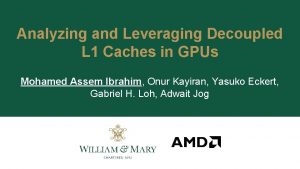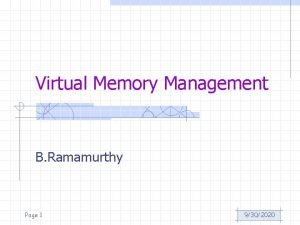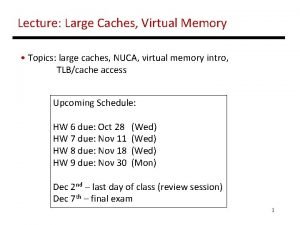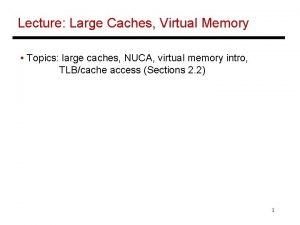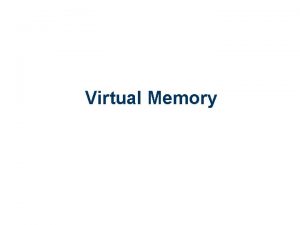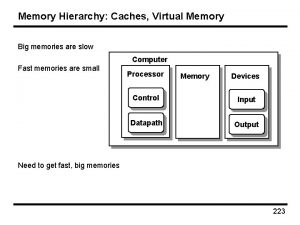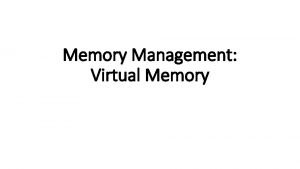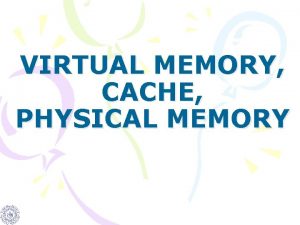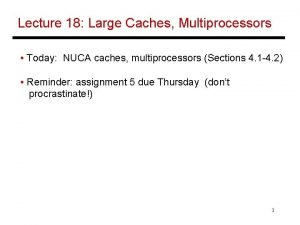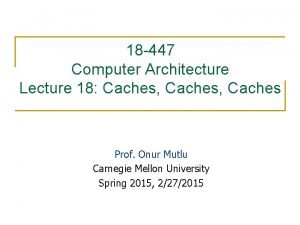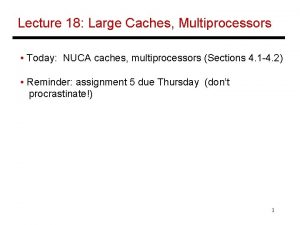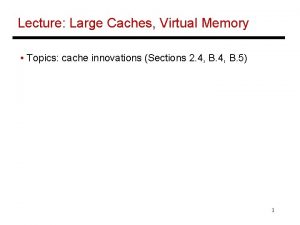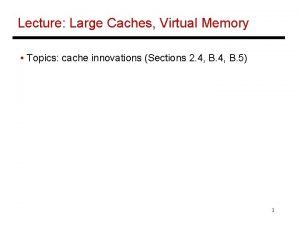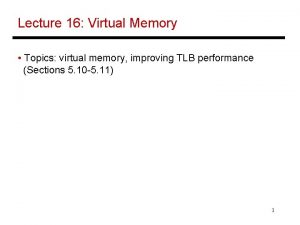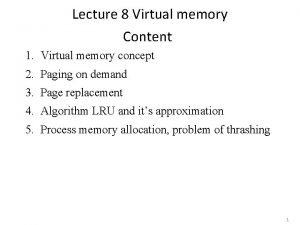Lecture 20 Caches and Virtual Memory Lecture 20


















- Slides: 18

Lecture 20 Caches and Virtual Memory Lecture 20 – Caching and Virtual Memory Ó 2004 Morgan Kaufmann Publishers 1

Memories: Review • SRAM: – value is stored on a pair of inverting gates – very fast but takes up more space than DRAM (4 to 6 transistors) • DRAM: – value is stored as a charge on capacitor (must be refreshed) – very small but slower than SRAM (factor of 5 to 10) Lecture 20 – Caching and Virtual Memory Ó 2004 Morgan Kaufmann Publishers 2

Exploiting Memory Hierarchy • Users want large and fast memories! SRAM Disk • . 5 – 5 ns $4000 to $10, 000 per GB. 50 -70 ns $100 to $200 per GB. 5 to 20 million ns $. 50 to $2 per GB. 2004 Build a memory hierarchy Lecture 20 – Caching and Virtual Memory Ó 2004 Morgan Kaufmann Publishers 3

Locality • A principle that makes having a memory hierarchy a good idea • If an item is referenced, temporal locality: it will tend to be referenced again soon spatial locality: nearby items will tend to be referenced soon. Why does code have locality? • Our initial focus: two levels (upper, lower) – block: minimum unit of data – hit: data requested is in the upper level – miss: data requested is not in the upper level Lecture 20 – Caching and Virtual Memory Ó 2004 Morgan Kaufmann Publishers 4

Cache • • Two issues: – How do we know if a data item is in the cache? – If it is, how do we find it? Our first example: – block size is one word of data – "direct mapped" For each item of data at the lower level, there is exactly one location in the cache where it might be. e. g. , lots of items at the lower level share locations in the upper level Lecture 20 – Caching and Virtual Memory Ó 2004 Morgan Kaufmann Publishers 5

Direct Mapped Cache • Mapping: address is modulo the number of blocks in the cache Lecture 20 – Caching and Virtual Memory Ó 2004 Morgan Kaufmann Publishers 6

Direct Mapped Cache • For MIPS: What kind of locality are we taking advantage of? Lecture 20 – Caching and Virtual Memory Ó 2004 Morgan Kaufmann Publishers 7

Direct Mapped Cache • Taking advantage of spatial locality: Lecture 20 – Caching and Virtual Memory Ó 2004 Morgan Kaufmann Publishers 8

Hits vs. Misses • Read hits – this is what we want! • Read misses – stall the CPU, fetch block from memory, deliver to cache, restart • Write hits: – can replace data in cache and memory (write-through) – write the data only into the cache (write-back the cache later) • Write misses: – read the entire block into the cache, then write the word Lecture 20 – Caching and Virtual Memory Ó 2004 Morgan Kaufmann Publishers 9

Performance • Increasing the block size tends to decrease miss rate: • Use split caches because there is more spatial locality in code: Lecture 20 – Caching and Virtual Memory Ó 2004 Morgan Kaufmann Publishers 10

Performance • Simplified model: execution time = (execution cycles + stall cycles) ´ cycle time stall cycles = # of instructions ´ miss ratio ´ miss penalty • Two ways of improving performance: – decreasing the miss ratio – decreasing the miss penalty What happens if we increase block size? Lecture 20 – Caching and Virtual Memory Ó 2004 Morgan Kaufmann Publishers 11

Virtual Memory • Main memory can act as a cache for the secondary storage (disk) • Advantages: – illusion of having more physical memory – program relocation – protection Lecture 20 – Caching and Virtual Memory Ó 2004 Morgan Kaufmann Publishers 12

Pages: virtual memory blocks • Page faults: the data is not in memory, retrieve it from disk – huge miss penalty, thus pages should be fairly large (e. g. , 4 KB) – reducing page faults is important (LRU is worth the price) – can handle the faults in software instead of hardware – using write-through is too expensive so we use writeback Lecture 20 – Caching and Virtual Memory Ó 2004 Morgan Kaufmann Publishers 13

Page Tables Lecture 20 – Caching and Virtual Memory Ó 2004 Morgan Kaufmann Publishers 14

Page Tables Lecture 20 – Caching and Virtual Memory Ó 2004 Morgan Kaufmann Publishers 15

Making Address Translation Fast • A cache for address translations: translation lookaside buffer Typical values: Lecture 20 – Caching and Virtual Memory 16 -512 entries, miss-rate: . 01% - 1% miss-penalty: 10 – 100 cycles Ó 2004 Morgan Kaufmann Publishers 16

TLBs and Caches Lecture 20 – Caching and Virtual Memory Ó 2004 Morgan Kaufmann Publishers 17

Further steps • Read the rest of the book • Take Computer Architecture • Take Operating Systems Lecture 20 – Caching and Virtual Memory Ó 2004 Morgan Kaufmann Publishers 18
 Analyzing and leveraging decoupled l1 caches in gpus
Analyzing and leveraging decoupled l1 caches in gpus L caches
L caches Virtual memory
Virtual memory Virtual memory in memory hierarchy consists of
Virtual memory in memory hierarchy consists of Internal memory and external memory
Internal memory and external memory Primary memory and secondary memory
Primary memory and secondary memory Has virtual functions and accessible non-virtual destructor
Has virtual functions and accessible non-virtual destructor 01:640:244 lecture notes - lecture 15: plat, idah, farad
01:640:244 lecture notes - lecture 15: plat, idah, farad Shape memory alloys lecture notes
Shape memory alloys lecture notes Prototypes in semantics
Prototypes in semantics Explicit and implicit memory
Explicit and implicit memory Long term memory vs short term memory
Long term memory vs short term memory Physical memory vs logical memory
Physical memory vs logical memory Which memory is the actual working memory?
Which memory is the actual working memory? Eidetic memory vs iconic memory
Eidetic memory vs iconic memory Symmetric shared memory architecture
Symmetric shared memory architecture Virtual memory
Virtual memory Virtual memory management techniques
Virtual memory management techniques Virtual memory in operating system
Virtual memory in operating system
